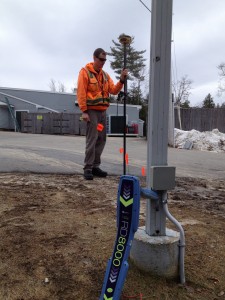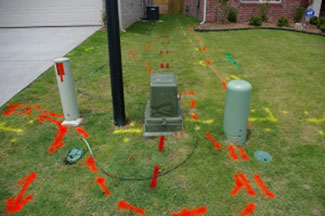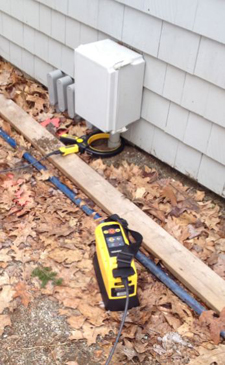 AAB is a certified and insured utility locating company established in 2009 by James D. Nadeau, owner of Nadeau Land Surveys. Founded on the belief that utility locating and land surveying are symbiotic in their intent to transform the unknown into reliable data, we offer an innovative and unique integration of services, including location, identification, and survey-grade mapping of underground infrastructure to meet the needs of clients from many different industries and professions.
AAB is a certified and insured utility locating company established in 2009 by James D. Nadeau, owner of Nadeau Land Surveys. Founded on the belief that utility locating and land surveying are symbiotic in their intent to transform the unknown into reliable data, we offer an innovative and unique integration of services, including location, identification, and survey-grade mapping of underground infrastructure to meet the needs of clients from many different industries and professions.
Our goal is to provide peace of mind, as we strive to protect our clients from costly damage and the dangers associated with ground excavating. With field equipment such as the Topcon Hyper II GPS, Radiodetection RD8000, MALA Ground Penetrating Radar, Radiodetection C.A.T. 4+, Pipehorn 100, Vivax-Metrotech VM-810, and various models of Schonstedt magnetic locators, we are able to serve as consultants from project feasibility to final as-built plans.
We also offer an informative monthly email newsletter called Above And Below. This newsletter is free and is delivered on the third Wednesday of every month. Click here to subscribe!
WHY LOCATE?
Safety First!
State law requires that before any excavation occurs, an affiliate of the Common Ground Alliance must be called. This is often referred to as the “one-call system”. Call 811 is the federally-mandated “Call Before You Dig” national number. In the New England area, you reach Dig Safe. Notification of excavation is required whether you are planting a tree, installing a fence, or undertaking a large construction project. Excavation at any depth has the potential to damage utility infrastructure if not properly located and marked, which can lead to personal harm or death, service disruption to an entire area, and sizeable fines and penalties for the responsible party.
Cost Savings
The annual cost due to utility damage is in the billions of dollars, and one of the leading causes of accidents and disruptions is inaccurate records and locating. The untimely discovery of an unknown underground utility needing relocation is one of the major causes of delay during construction projects, often causing budget overruns. Contracting a private utility locator, especially one that can acquire utility elevations during the design stage of a project will save you time and money in the long run.
Future Planning
Many utilities that once had a known horizontal location often have to be found again, especially when excavations and backfilling cover up or remove the markings. One-call systems are clearly necessary and have contributed greatly to increased public safety. Now, technology is available to complement those systems with reliable database information, such as Geographic Information System (GIS) and State Plane Coordinates, and allows for a practical approach for long term safety and data storage. Any future excavation would still require the one-call notification, but imagine how much more efficiently a project could be executed with access to accurate maps showing underground facilities layered with roads, buildings, elevations, hydrography, and other land features. This concept has been globally recognized as a vital step forward in the industry and we are excited to be a part of the movement.
AAB Utility Locating has the resources to research, identify, locate, and map underground facilities.
OUR SERVICES AND PRODUCTS
- Field location of private and public above ground and subsurface utility infrastructure, with or without elevations. Obtaining elevations is best when performed prior to backfilling, and will aid greatly in the final as-built process.
- Accurate identification of utilities for design, planning, or excavation purposes.
- Loss prevention through diligent research.
- Insured final plans prepared by a State of Maine Professional Land Surveyor.
- Using GIS, we can integrate utility data with other GIS data, creating a multi-layered plan in a format that can be efficiently used in different applications, such as municipal as-built approvals. This data will be stored for future use.
- With the use of a Global Positioning System, coordinate values can be placed on a variety of geographic coordinate systems and horizontal and vertical datums.
ABOUT THE ONE-CALL SYSTEM
The one-call system (Call 811) is the first step to take before excavating. It gives notice of excavation according to state law, and arranges for member companies* to locate and mark the utilities that they own and maintain, in the area you specify. (This area must be specified and pre-marked before you call Dig Safe so member companies know where to locate.) If excavation outside of the pre-marked area is necessary, a separate Dig Safe permit will be required. Failure to pre-mark may jeopardize permitting and result in civil penalties.
It is very important to understand that one-call utility locating does not guarantee location and marking of all the utilities in that area, only those of the member companies, and typically only those on public property. Often times, local water and sewer utility companies are not members of the Dig Safe system. In Maine, the only utilities required to participate are gas, electric, telephone, and cable television. In order to maintain the highest level of safety, it is recommended that you have all utilities located before excavating.
*Dig Safe is a free service, funded entirely by its member companies. A list of those companies can be found on their website.
Keep these important points in mind, when considering your project:
 Even with a Dig Safe ticket, member utility companies will not mark private utilities. Private utilities are buried lines that extend beyond a public right of way and onto your property, such as those coming from a curbside meter or transformer. This may include secondary electric lines going from a transformer to the house and also to lamps or garages, septic, fire mains, and sprinklers, among others. This leaves a number of utilities that will remain unmarked unless a private utility locator is contracted. Just because Dig Safe’s member companies do not locate them, does not mean they do not need to be located. Doing so will prevent damages and the need to redesign plans. Remember, unmarked utilities = potential danger.
Even with a Dig Safe ticket, member utility companies will not mark private utilities. Private utilities are buried lines that extend beyond a public right of way and onto your property, such as those coming from a curbside meter or transformer. This may include secondary electric lines going from a transformer to the house and also to lamps or garages, septic, fire mains, and sprinklers, among others. This leaves a number of utilities that will remain unmarked unless a private utility locator is contracted. Just because Dig Safe’s member companies do not locate them, does not mean they do not need to be located. Doing so will prevent damages and the need to redesign plans. Remember, unmarked utilities = potential danger.
Dig Safe does not notify non-member companies of your desire to excavate; it is your responsibility to do so. The Maine Public Utilities Commission has compiled a list of non-member companies to help you.
Dig Safe only functions as a call center; it does not actually locate or mark utilities, nor will they submit a request for public utility companies to do so for design purposes, only for excavations.
For design purposes, you must contact the member company or facility owner directly. Please keep in mind that although those companies may have maps and drawings available to assist you, those records can become outdated. The design phase of a major project is a critical time to have accurate data. We recommend having all utilities located and mapped during this time, and not relying on old data.
A Dig Safe ticket is always required for excavation and must be requested at least 3 business days prior and should only be processed if you intend to excavate within 60 days in the State of Maine.
OUR EQUIPMENT AND LOCATING METHODS
 With infrastructure constantly expanding, the network of underground utility lines below our feet continues to become more complex and congested. Cables and pipes layer upon each other at various depths and directions, serving different purposes, each one with a potential to pose great risk should it be damaged during excavation. For safety and future planning, it is vital to understand the location of these facilities. This involves different methods of locating, and reinforces the benefit of storing data for long term use.
With infrastructure constantly expanding, the network of underground utility lines below our feet continues to become more complex and congested. Cables and pipes layer upon each other at various depths and directions, serving different purposes, each one with a potential to pose great risk should it be damaged during excavation. For safety and future planning, it is vital to understand the location of these facilities. This involves different methods of locating, and reinforces the benefit of storing data for long term use.
In general, metallic utilities are located through “electromagnetic induction”, using a transmitter to apply an electromagnetic field that wraps around the conducting metal of the cable. When possible, the transmitter is connected to the utility using a signal clamp, forming a direct connection (see photo). The receiver, or wand, from the paired equipment is then tuned to the oscillation frequency of the electromagnetic field and swept across the area, tracing the position of the field as it travels down the path of the conducting metal of the utility. When a direct connection is not possible, the transmitter induces the signal into the ground and the receiver picks it up as re-radiates from the utility.
 The electromagnetic induction method is typically used first, because many wires and cables that are metallic are too small in diameter to be found reliably with a Ground Penetrating Radar. But for larger subsurface utilities, and non-metallic utilities that are unable to carry an electromagnetic field, we use the MALA Ground Penetrating (GPR). The GPR uses radar pulses in the microwave band of the radio spectrum to create subsurface images.
The electromagnetic induction method is typically used first, because many wires and cables that are metallic are too small in diameter to be found reliably with a Ground Penetrating Radar. But for larger subsurface utilities, and non-metallic utilities that are unable to carry an electromagnetic field, we use the MALA Ground Penetrating (GPR). The GPR uses radar pulses in the microwave band of the radio spectrum to create subsurface images.
The GPR is the ideal instrument for finding facilities made of concrete, clay, or plastic, and is more useful at determining depths of non-conductive utilities than any electromagnetic instrument.
 The congestion of underground facilities, type and condition of lines, and the condition of the ground will influence method of location. This means that not only is it necessary to utilize current locating equipment, but since ground conditions will change in the future, the locations of these lines need to be recorded, and better yet, they should be mapped. For accurate facility location, we use the Topcon Hyper II GPS. This allows us to take GPS coordinates along the path of marked utilities. The coordinates can then be placed in a recognized coordinate system or uploaded into a geographic layer in GIS.
The congestion of underground facilities, type and condition of lines, and the condition of the ground will influence method of location. This means that not only is it necessary to utilize current locating equipment, but since ground conditions will change in the future, the locations of these lines need to be recorded, and better yet, they should be mapped. For accurate facility location, we use the Topcon Hyper II GPS. This allows us to take GPS coordinates along the path of marked utilities. The coordinates can then be placed in a recognized coordinate system or uploaded into a geographic layer in GIS.



